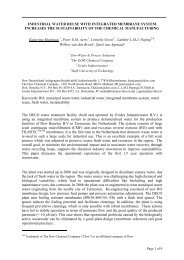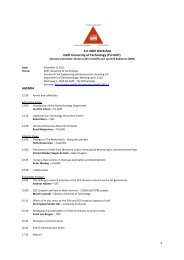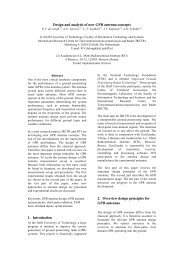CHAPTER 5 CONCRETE PAVEMENTS - TU Delft
CHAPTER 5 CONCRETE PAVEMENTS - TU Delft
CHAPTER 5 CONCRETE PAVEMENTS - TU Delft
Create successful ePaper yourself
Turn your PDF publications into a flip-book with our unique Google optimized e-Paper software.
Figure 5.3: Transverse contraction joint with dowel bar.<br />
In longitudinal contraction joints so-called ty bars are applied to prevent two adjacent<br />
rows of concrete slabs to float away from each other due to variation of the absolute<br />
temperature. The ty bars are located at mid-height, or even somewhat higher, of the<br />
concrete slab. The profiled steel ty bars have a diameter of 16 mm and a length of at<br />
least 600 mm. At both ends the ty bars are fixed into the concrete, however the<br />
central one-third part of the ty bar has a coating (which prevents bond to the<br />
concrete) to distribute the occurring movements of the concrete slabs due to varying<br />
absolute temperatures over a sufficient length so that no flow of the ty bar steel<br />
occurs (figure 5.4). In longitudinal contraction joints normally 3 ty bars per concrete<br />
slab length are applied (see figure 5.2).<br />
Figure 5.4: Longitudinal contraction joint with ty bar.<br />
Contraction joints are made by sawing a 3 mm wide cut into the hardening concrete.<br />
This sawing has to be done as soon as possible and certainly within 24 hours after<br />
the placement of the concrete. The depth of the saw cut for longitudinal contraction<br />
joints should be 40 to 45% of the concrete thickness and for transverse contraction<br />
joints about 35% of the concrete thickness. By these saw cuts the concrete is<br />
weakened to such an extent that the inevitable cracks (due to shrinkage of the<br />
hardening concrete or a decrease of the absolute temperature of the hardened<br />
concrete) will appear below the saw cuts.<br />
The joints may remain open (which is usually done at rural roads) or they may be<br />
filled. In this latter case by further sawing the joints have to be widened (e.g. to 8 mm)<br />
to a certain depth to enable filling of the joints (with a bituminous material or with<br />
special hollow plastic profiles) and to limit the strains in the joint-filling material at<br />
changing joint widths due to temperature variations.<br />
On roads the thickness of plain concrete pavements varies between 180 mm (bicycle<br />
tracks) and 300 mm (motorways). On airports and other very heavily loaded<br />
pavements a plain concrete pavement with a thickness up to 450 mm is applied.<br />
167











